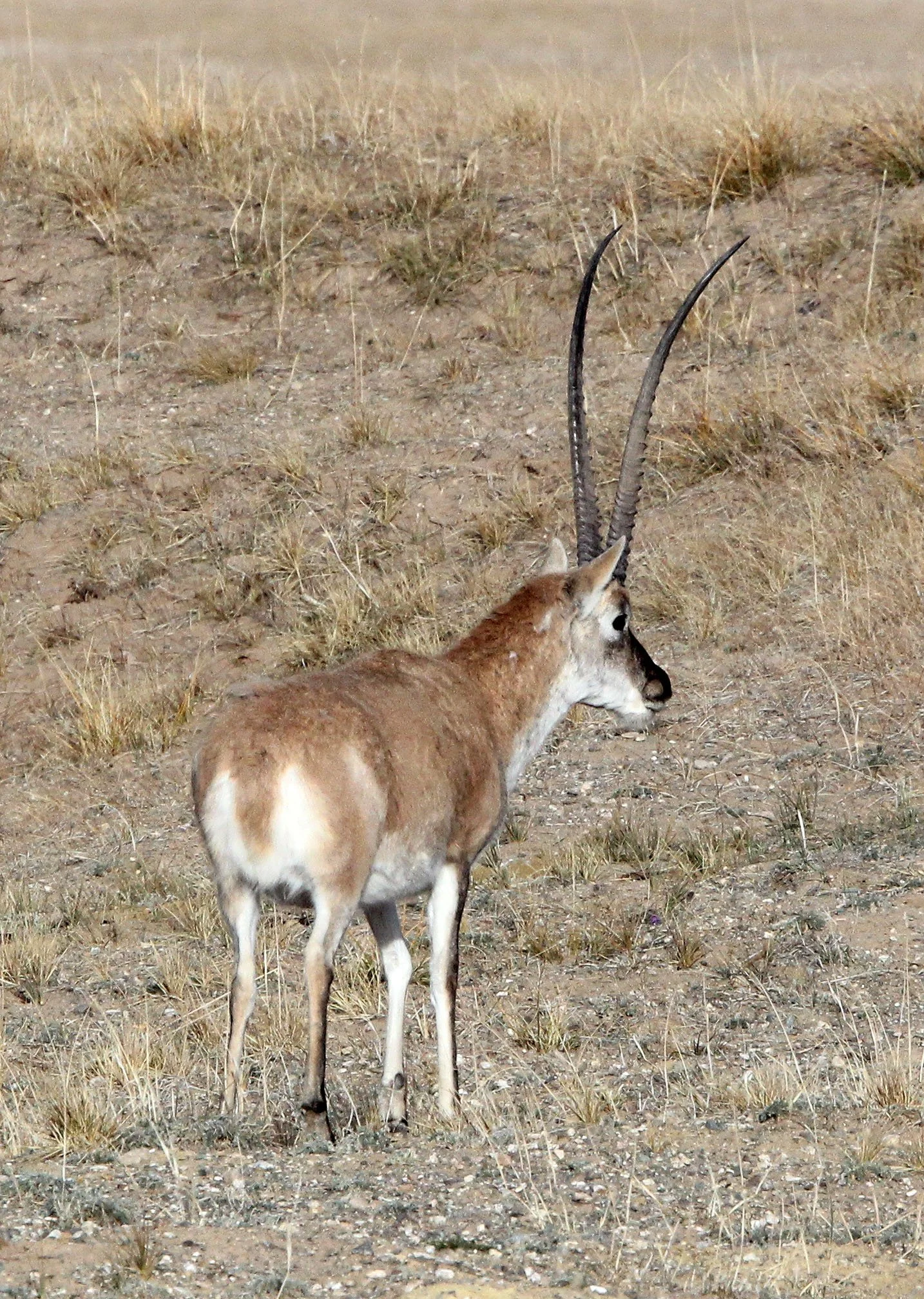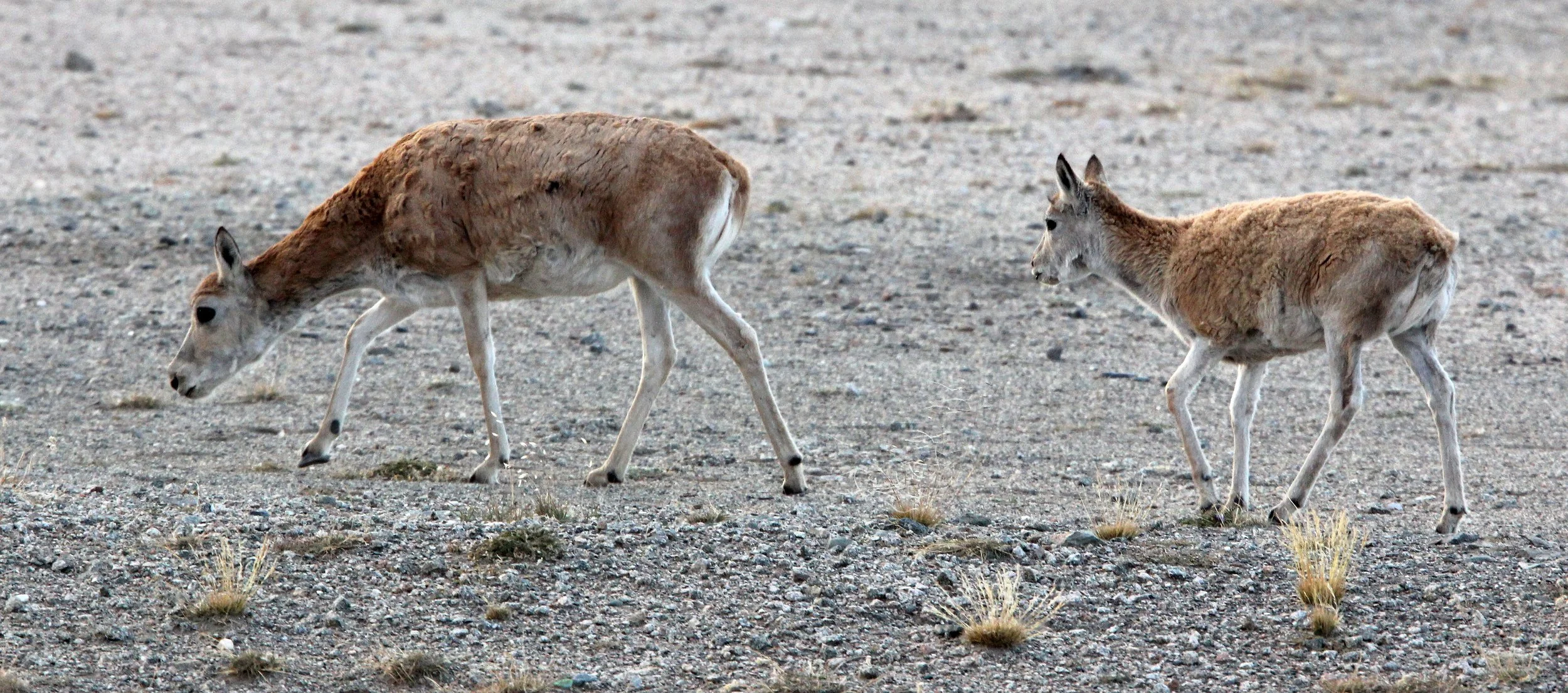
Tibetan Antelope or Chiru (Pantholops hodgsonii)
The Tibetan antelope or chiru (Pantholops hodgsonii) (Tibetan: གཙོད་, Wylie: gtsod, pronounced [tsǿ]; Chinese: 藏羚羊; pinyin: zànglíngyáng[5]) is a medium-sized bovid native to the northeastern Tibetan plateau. Most of the population live within the Chinese border, while some scatter across India and Bhutan. Fewer than 150,000 mature individuals are left in the wild, but the population is currently thought to be increasing. In 1980s and 1990s, they had become endangered due to massive illegal poaching. They are hunted for their extremely soft, light and warm underfur which is usually obtained after death. This underfur, known as shahtoosh (a Persian word meaning "king of fine wools"), is used to weave luxury shawls. Shahtoosh shawls were traditionally given as wedding gifts in India and it takes the underfur of three to five adult antelopes to make one shawl. Despite strict controls on trade of shahtoosh products and CITES listing, there is still demand for these luxury items. Within India, shawls are worth $1,000–$5,000; internationally the price can reach as high as $20,000. In 1997 the Chinese government established the Hoh Xil National Nature Reserve (also known as Kekexili) solely to protect the Tibetan antelope population.
Male Tibetan Antelope in Ke Ke Xi Li Reserve, Qinghai
The Tibetan antelope is the sole species in the genus Pantholops, named after the Greek for "all antelope". It was formerly classified in the then-subfamily Antilopinae (now thought to be the tribe Antilopini), but morphological and molecular evidence led to it being placed in its own subfamily, Pantholopinae, closely allied to goat-antelopes of the then-subfamily Caprinae. However, this has been disputed, and most authorities now consider the Tibetan antelope to be a true member of the Caprinae, or the tribe Caprini. Phylogenetic evidence indicates that Pantholops is the most basal member of the Caprinae / Caprini, and belongs to its own tribe or subtribe, Pantholopini or Pantholopina.
Although the genus Pantholops is currently monotypic, a fossil species, P. hundesiensis, is known from the Pleistocene of Tibet. It was slightly smaller than the living species, with a narrower skull. In addition, the fossil genus Qurliqnoria, from the Miocene of China, is thought to be an early member of the Pantholopini, which diverged from the goat-antelopes around this time.
The Tibetan antelope is a medium-sized antelope, with a shoulder height of about 83 cm (32+1⁄2 in) in males, and 74 cm (29 in) in females. Males are significantly larger than females, weighing about 39 kg (86 lb), compared with 26 kg (57 lb), and can also be readily distinguished by the presence of horns and by black stripes on the legs, both of which the females lack. The coat is pale fawn to reddish-brown, with a whitish belly, and is particularly thick and woolly. The face is almost black in colour, with prominent nasal swellings that have a paler colour in males. In general, the colouration of males becomes more intense during the annual rut, with the coat becoming much paler, almost white, contrasting with the darker patterns on the face and legs.
The males have long, curved-back horns that typically measure 54 to 60 cm (21 to 24 in) in length. The horns are slender, with ring-like ridges on their lower portions and smooth, pointed, tips. Although the horns are relatively uniform in length, there is some variation in their exact shape, so the distance between the tips can be quite variable, ranging from 19 to 46 cm (7+1⁄2 to 18 in). Unlike caprines, the horns do not grow throughout life. The ears are short and pointed, and the tail is also relatively short, at around 13 cm (5 in) in length.
The fur of Tibetan antelopes is distinctive, and consists of long guard hairs and a silky undercoat of shorter fibres. The individual guard hairs are thicker than those of other goats, with unusually thin walls, and have a unique pattern of cuticular scales, said to resemble the shape of a benzene ring.
Female herd in Ke Ke Xi Li
Endemic to the Tibetan Plateau, the Tibetan antelope inhabits open alpine and cold steppe environments between 3,250 and 5,500 m (10,660 and 18,040 ft) elevation. They prefer flat, open terrain, with sparse vegetation cover. They are found almost entirely in China, where they inhabit Tibet, southern Xinjiang, and western Qinghai; a few are also found across the border in Ladakh, India. The westernmost population of Tibetan antelope is in Depsang Plains, where they are found at altitudes of up to 5500 m. Today, the majority are found within the Chang Tang Nature Reserve of northern Tibet. The first specimens to be described, in 1826, were from Nepal; the species has apparently since been extirpated from the region. No subspecies are recognised. Zhuonai Lake (卓乃湖) in Hoh Xil is known as a calving ground for the Tibetan antelope.
A special adaptation of the species to its high altitude habitat is the retention of the fetal version of hemoglobin even in adult animals, which provides higher oxygen affinity. The Tibetan antelope is the only species of mammal where this adaptation has been documented.
Tibetan antelope feed on forbs, grasses, and sedges, often digging through the snow to obtain food in winter. Their natural predators include wolves, lynx, and snow leopards, and red foxes are known to prey on young calves.
Tibetan antelope are gregarious, sometimes congregating in herds hundreds strong when moving between summer and winter pastures, although they are more usually found in much smaller groups, with no more than 20 individuals. The females migrate up to 300 km (200 mi) yearly to calving grounds in the summer, where they usually give birth to a single calf, and rejoin the males at the wintering grounds in late autumn.
Tibetan antelope or chiru (Pantholops hodgsonii) - Ke Ke Xi Li Wildlife Reserve, Tibetan Plateau Qinghai & Tibet










































































































































































